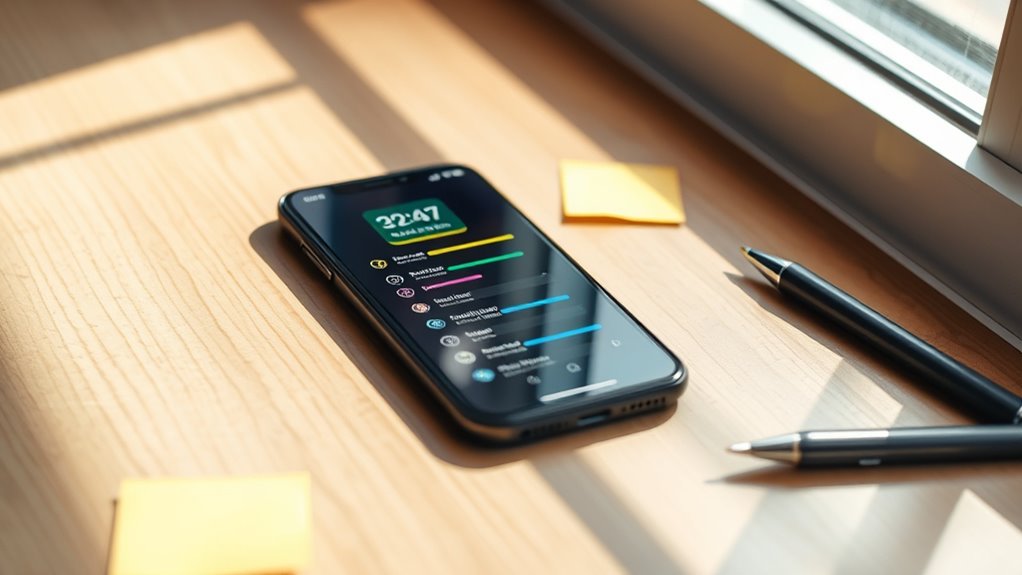Zeigarnik Effect apps boost your task completion by visually emphasizing unfinished work with progress bars, color coding, and reminders. They leverage your natural tendency to focus on open loops, motivating you to close tasks before mental tension fades. These tools use notifications, streaks, and visual cues to keep you engaged and reduce mental clutter. If you’re curious about how these strategies work in detail, you’ll find more insights if you continue exploring.
Key Takeaways
- Zeigarnik-inspired apps use visual cues like progress bars and color coding to motivate task completion by highlighting unfinished work.
- Popular tools such as Todoist, Trello, and Notion incorporate reminders, notifications, and visual markers to re-engage users with open tasks.
- These apps leverage micro-rewards, streaks, and milestones to sustain motivation based on the Zeigarnik Effect.
- Advanced features include real-time feedback, adaptive notifications, and emotional AI to personalize encouragement and improve focus.
- Integration of AR and data analytics in modern apps enhances task visibility, provides immersive cues, and tracks progress for better completion rates.
Understanding the Zeigarnik Effect and Its Implications
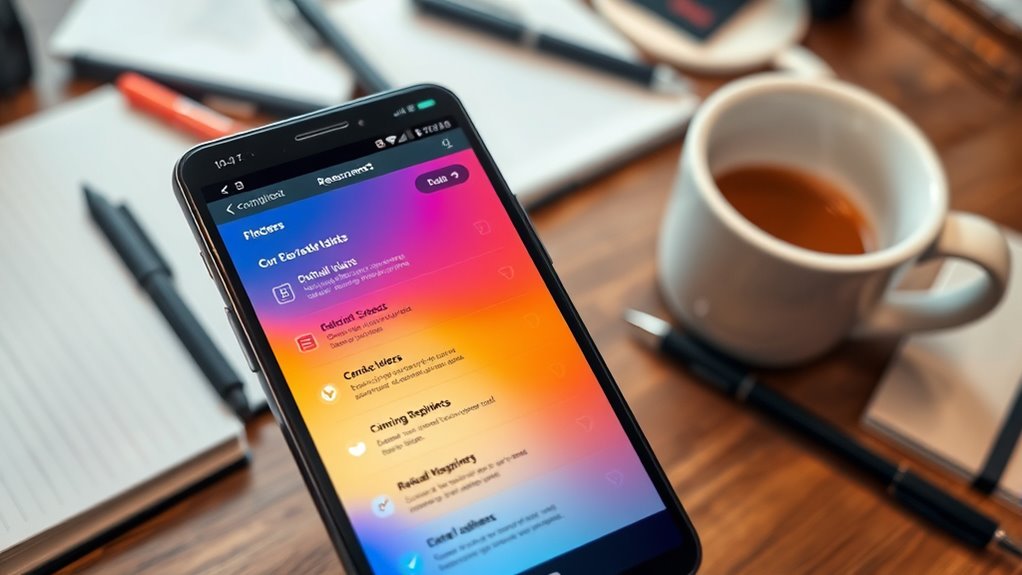
The Zeigarnik Effect reveals how unfinished tasks stay more vivid in your memory than completed ones, influencing your thoughts and actions. This psychological phenomenon occurs because incomplete tasks create cognitive tension, causing your mind to loop thoughts and keep these tasks at the forefront of your memory. This tension leads to increased mental energy being allocated to these tasks, which can either motivate you to complete them or cause mental fatigue. Lesser-known spots provide tranquil environments that can help you focus on completing tasks without distractions. Named after psychologist Bluma Zeigarnik, who discovered the effect in 1927, it explains why unfinished tasks demand mental energy and often distract you. Understanding this effect is essential for task management, as it shows how open loops can affect motivation and focus. Recognizing the psychological impact of incomplete tasks allows you to develop targeted strategies to better manage your cognitive resources and reduce mental clutter. Additionally, awareness of this effect can inform your approach to time management, helping you prioritize and complete tasks more efficiently. Instead of ignoring incomplete tasks, recognizing the Zeigarnik Effect helps you harness this mental drive, encouraging you to finish tasks or manage your mental focus more effectively.
How Task Completion Apps Leverage Cognitive Biases
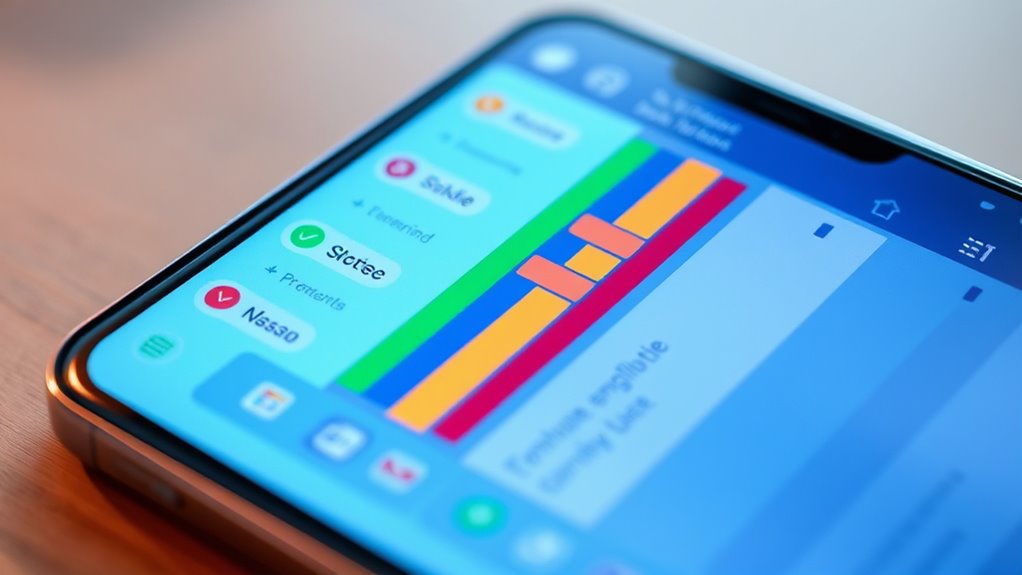
Task completion apps harness the power of cognitive biases, particularly the Zeigarnik Effect, to keep you engaged and motivated. They emphasize unfinished tasks through visual cues like progress indicators and reminders, creating mental tension that compels you to complete them. Recognizing the WWE Raw’s Financial Impact influence on the entertainment industry underscores the importance of completing large-scale projects, which these apps can help facilitate. Breaking tasks into smaller milestones taps into your innate desire for closure, encouraging steady progress. Notifications about pending or overdue tasks act as external cues, reinforcing the mental pull of open loops. These apps also incorporate reward systems and streaks, leveraging the Zeigarnik Effect to motivate you to resolve unfinished tasks for a sense of satisfaction. Additionally, understanding the Essential Oils for Dizziness Relief can be integrated into your routine to support overall well-being and reduce stress, further enhancing your focus and productivity. Employing visual cues, such as color-coded task lists or progress bars, can strengthen the psychological impact of unfinished tasks and boost engagement. Incorporating security features such as data encryption and authentication helps protect your information and builds trust in these productivity tools. By highlighting incomplete work and tapping into your natural response to unresolved tasks, these tools boost app engagement and help you stay focused until everything is completed.
Features of Effective Zeigarnik-Inspired Tools
Effective Zeigarnik-inspired tools rely on clear task visualization to keep you aware of your progress and unfinished work. Seamless progress tracking helps you see how far you’ve come, motivating you to finish what you start. Consistent messaging can strengthen your productivity habits and reinforce your commitment to completing tasks. Action-oriented reminders keep your tasks top of mind without overwhelming you, ensuring consistent momentum. Incorporating organized space principles can further enhance your ability to manage tasks efficiently and maintain focus. Recognizing core personality traits can also assist in customizing these tools to better suit individual behavioral tendencies. Understanding retail hours can help users plan their browsing and task-related shopping more effectively.
Clear Task Visualization
Clear visual cues play a crucial role in Zeigarnik-inspired apps by highlighting ongoing work and keeping you focused. Task visualization helps you see incomplete tasks at a glance, making it easier to prioritize and manage your workload. Visual cues like progress indicators, bolded items, or color coding quickly communicate which tasks are pending—red for incomplete, green for completed—so you can assess your progress instantly. These visual elements boost user engagement by providing immediate feedback, encouraging you to stay committed to task completion. Well-designed tools break down complex projects into smaller subtasks, each with clear visual markers, supporting effective task management. By making progress visible and easy to interpret, these apps motivate you to address unfinished work consistently and efficiently. Incorporating visual cues inspired by research on attention and perception can further enhance focus and task completion. Additionally, leveraging visual hierarchy principles ensures that the most important tasks stand out, guiding your attention effectively. Using progress tracking features can also provide continuous motivation and a sense of achievement as you complete each step. For instance, integrating feedback mechanisms can help users recognize their accomplishments and areas needing improvement, reinforcing positive habits. Furthermore, integrating automation features can help streamline repetitive tasks, freeing up cognitive resources for more complex work.
Seamless Progress Tracking
Seamless progress tracking is essential for maintaining motivation and focus in Zeigarnik-inspired apps. It helps you stay aware of unfinished tasks through visual indicators like progress bars, checklists, and badges that highlight pending items. These tools automatically or manually save incomplete work so you can resume effortlessly, minimizing disruption. Real-time updates and notifications keep you aware of pending tasks, sustaining cognitive tension that pushes you toward completion. Advanced apps use color coding and visual cues to signal unfinished tasks, enhancing motivation. Data analytics help identify patterns of unfinished work, enabling better prioritization. Understanding narcissistic traits can also improve how you interpret your own productivity patterns and emotional responses to incomplete tasks. Incorporating mindfulness techniques into your workflow can further reduce stress associated with unfinished work and improve overall task management. Additionally, user feedback and engagement metrics are valuable for continuously refining app features to better support motivation and task completion. Regularly reviewing your progress data can provide insights that boost efficiency and goal achievement. Implementing reminder systems ensures that tasks are revisited and completed in a timely manner, maintaining steady progress. Here’s a visual overview:
| Feature | Benefit |
|---|---|
| Progress Bars | Show current task progress |
| Checklists | Highlight unfinished tasks |
| Visual Indicators | Signal pending items visually |
| Real-Time Updates | Keep you aware of task status |
| Data Analytics | Optimize workflow and prioritize tasks |
Action-Oriented Reminders
Action-oriented reminders are essential tools in Zeigarnik-inspired apps because they actively prompt you to revisit unfinished tasks before they fade from your memory. These reminders use visual cues like progress bars or incomplete task indicators to keep you focused and motivated, reducing cognitive load. A well-designed reminder system can also incorporate principles from ethical hacking, such as continuous monitoring and risk assessments, to adapt to your changing task priorities. Timely notifications serve as cues to re-engage with your open loops, preventing tasks from lingering unfinished. Breaking large tasks into smaller milestones creates achievable points that encourage task completion and sustain engagement. Micro-rewards for partial progress further motivate you to move forward. Integrating data analytics can help tailor reminders based on your past behavior, increasing their effectiveness. Research shows that well-designed, action-oriented reminders can boost task completion rates by up to 30%, making these features critical for improving your productivity and ensuring unfinished tasks stay top of mind until resolved.
Integrating Visual Cues to Enhance Task Closure
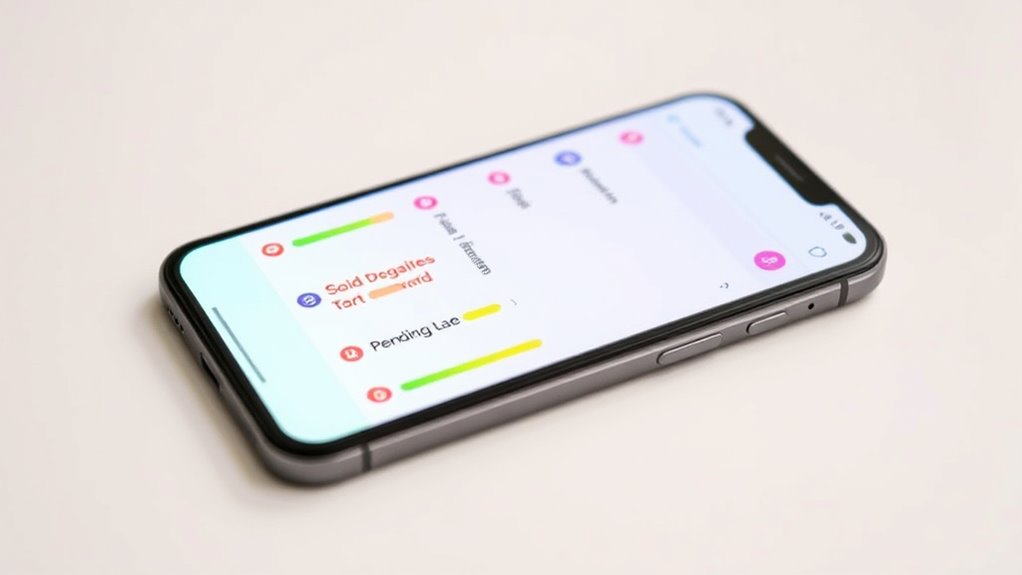
Using visual progress indicators and color coding can make unfinished tasks more noticeable and motivate you to complete them. These cues create a sense of urgency and help you track your progress easily.
Visual Progress Indicators
Visual progress indicators, such as progress bars and checklists, play a crucial role in harnessing the Zeigarnik Effect by providing clear visual cues of incomplete tasks. These cues motivate you to finish tasks by making progress visible, reducing cognitive dissonance.
When you see progress bars, you’re more likely to pursue task completion because they highlight remaining work. Color-coded cues, like red for incomplete and green for completed, boost visibility and tap into your brain’s desire for closure.
Breaking tasks into smaller segments with visual indicators helps maintain engagement and eases mental overload. Using visual cues in apps activates your natural tendency to seek closure, decreasing mental clutter and supporting sustained focus.
Urgency Through Color Coding
Color coding your tasks amplifies the sense of urgency, making unfinished work stand out immediately. Using bright or contrasting colors creates strong visual urgency, encouraging faster task completion. Red or orange hues evoke immediacy, leveraging the Zeigarnik Effect to reduce procrastination.
Consistent color coding for high-priority tasks provides intuitive cues that signal importance and motivate action. Visual cues like color-coded progress bars or labels help you quickly identify incomplete work, intensifying mental tension around unfinished tasks. This heightened awareness prompts you to prioritize effectively and close tasks faster.
Data shows that color coding can boost task completion rates by up to 25%, especially when combined with other visual reminders. By integrating visual cues through color, you enhance task prioritization and reduce lingering mental tension around incomplete work.
Strategies for Managing Unfinished Work in Digital Environments
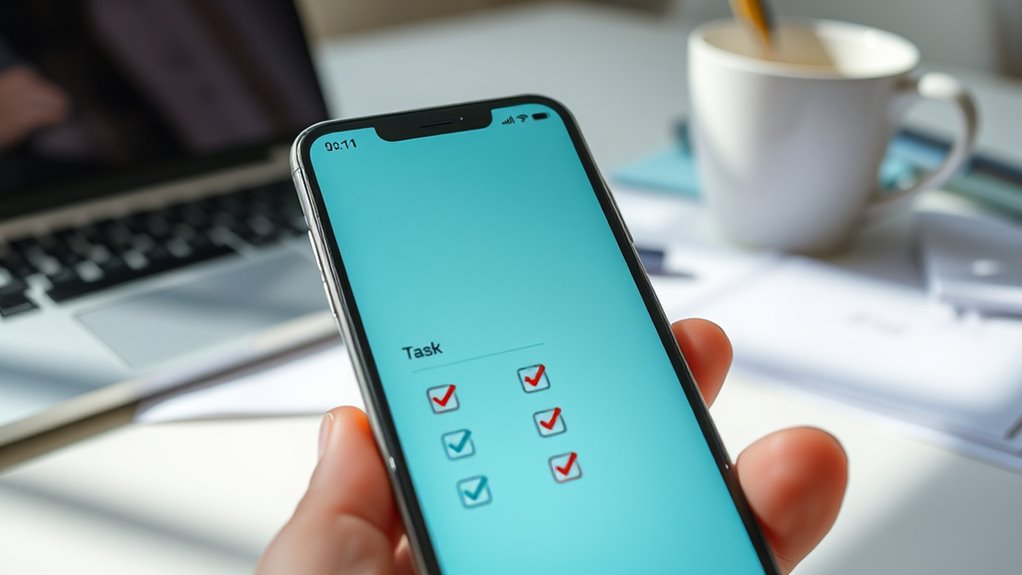
Managing unfinished work in digital environments requires deliberate strategies to prevent mental overload and maintain focus. To do this, you should:
- Use a single-page, text-based to-do list to track all tasks efficiently, reducing mental clutter.
- Break larger tasks into smaller, actionable steps during context switches to keep focus sharp.
- Regularly reorder and prioritize your to-do list, ensuring high-priority tasks stay visible and manageable.
- Add quick fixes or small milestones at the top of your list to ease cognitive tension and promote progress tracking.
- End your day with a review, marking tasks as complete to reduce rumination and clarify your next steps.
These practices help you manage unfinished work, improve task management, and ensure better task completion in digital environments.
The Role of Reminders and Notifications in Task Apps
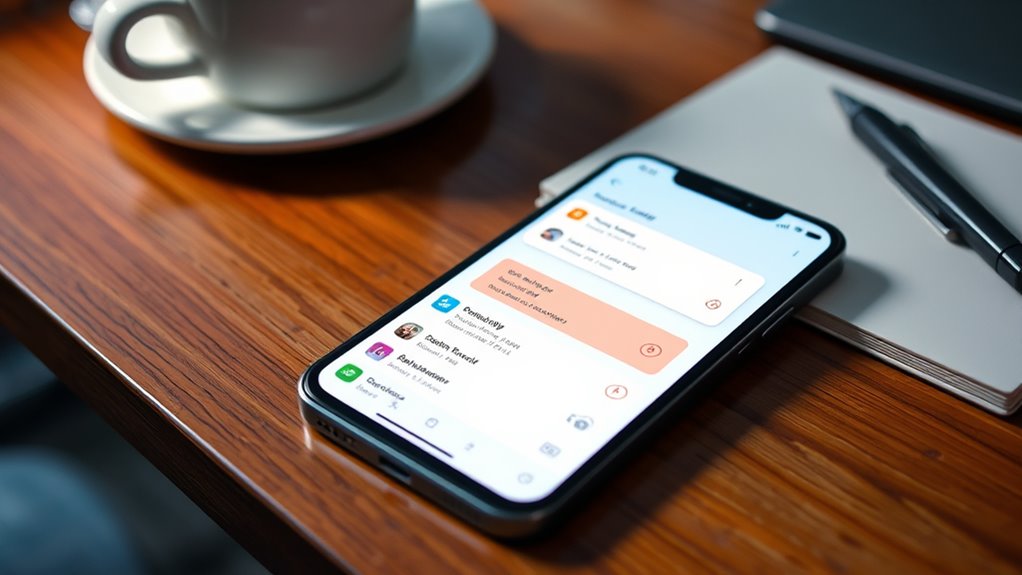
Have you ever noticed how a well-timed reminder can make all the difference in completing an unfinished task? Reminders and notifications act as prompt cues that re-engage your attention, leveraging the Zeigarnik Effect to push you toward task completion.
They prevent unfinished tasks from fading from your memory by maintaining cognitive tension, encouraging you to revisit and finish what you started. Customizable notifications help reinforce the urgency and importance of each task, increasing your motivation to act.
A well-designed reminder system reduces mental clutter by automating follow-ups, making it easier to manage your workload. Data shows that apps employing strategic reminders boost task completion rates by up to 30%, highlighting their essential role in increasing app engagement and finishing what you leave unfinished.
Case Studies of Popular Zeigarnik-Based Productivity Tools
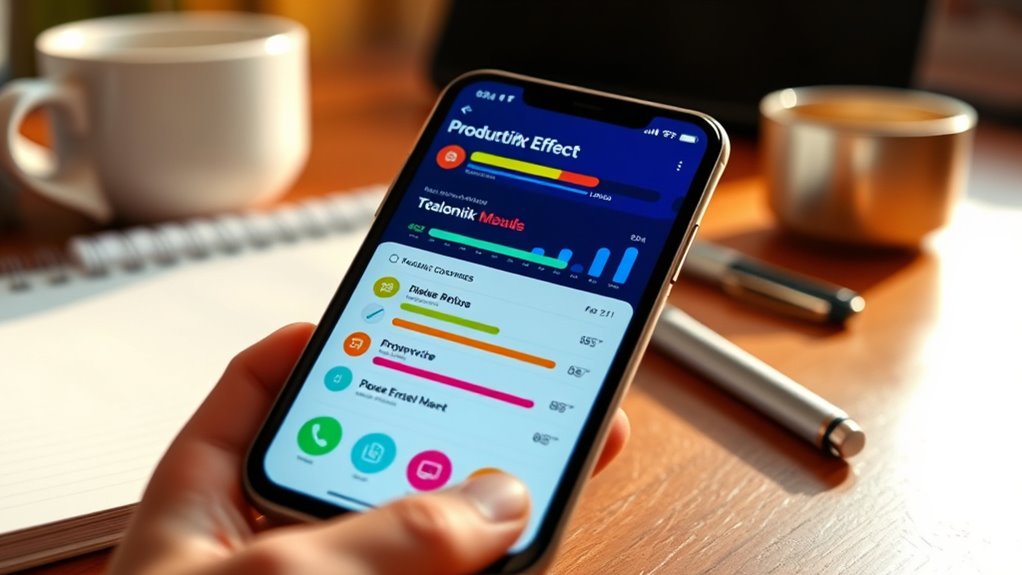
Popular productivity apps harness the Zeigarnik Effect through specific features designed to keep unfinished tasks visible and compelling. These visual cues and progress indicators tap into your desire to complete tasks, boosting user engagement.
For example:
- Trello uses incomplete cards and visual cues to remind you of pending work.
- Todoist employs recurring tasks, deadlines, and progress bars to highlight unfinished tasks.
- Habit-tracking apps like Loop and Streaks showcase streaks and uncompleted habits to motivate consistency.
- Notion integrates embedded checklists and unfinished page statuses to create cognitive tension.
- Beeminder applies goal-tracking with visual progress and penalties, encouraging you to avoid unfinished commitments.
These tools leverage visual cues and progress indicators, transforming the discomfort of unfinished tasks into a powerful motivator for task completion and consistent habit-tracking.
Practical Tips for Choosing the Right Task Completion App
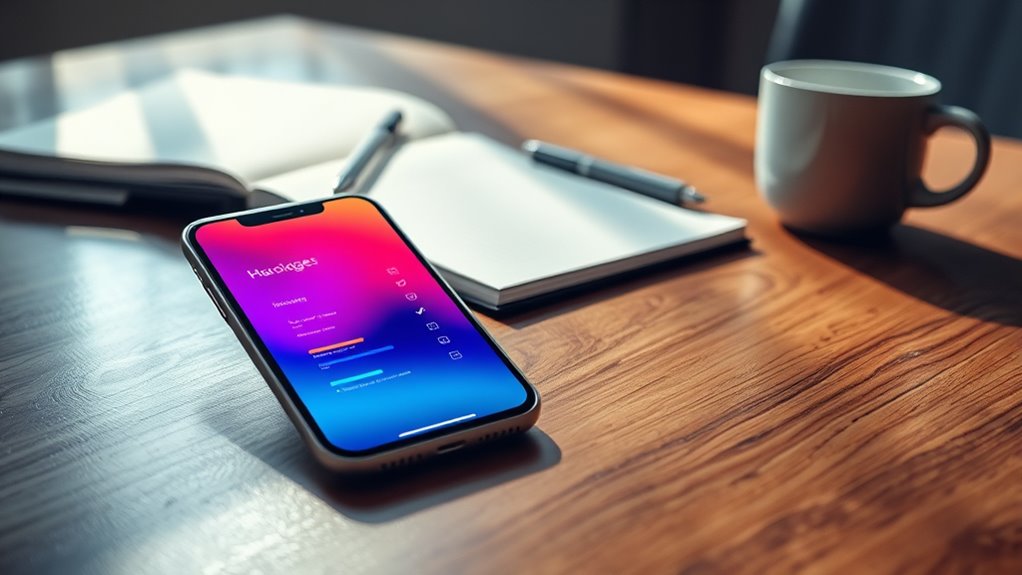
Choosing the right task completion app starts with focusing on visual cues that motivate you to finish tasks. Look for apps with clear progress tracking, like progress bars or checklists, to harness the Zeigarnik Effect and boost engagement.
Customizable notifications and reminders help reinforce unfinished tasks and prevent mental clutter. Make certain the app allows you to break large projects into subtasks, making progress feel achievable and encouraging closure.
Workflow integration is essential; pick tools that seamlessly connect with your existing productivity apps to streamline your workflow and reduce switching.
Lastly, apps with analytics or feedback features let you monitor your completion patterns, helping you refine your approach over time. Prioritizing these factors will help you find a task app that keeps you motivated and organized.
Future Trends in Zeigarnik Effect-Driven Productivity Technologies
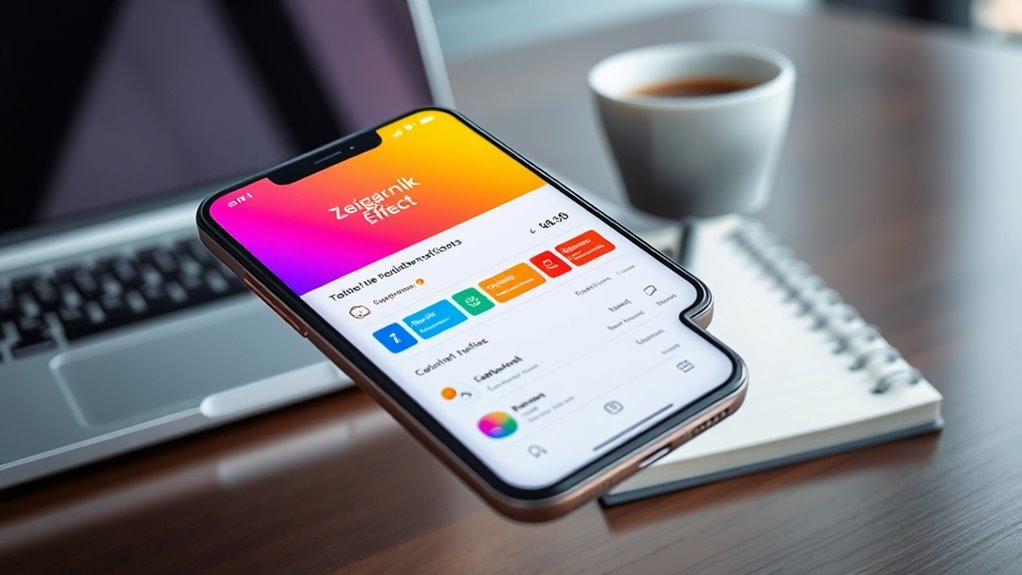
As technology advances, Zeigarnik Effect-driven productivity tools are set to become more personalized and immersive. Expect AI and machine learning to tailor task reminders and optimize task sequencing based on your behavior, making task management smarter.
Augmented reality (AR) will visually highlight incomplete tasks, engaging you more deeply in closure. Real-time feedback and adaptive notifications will reinforce unfinished work with context-aware prompts, boosting completion rates.
Emotion AI will analyze your frustration or stress levels, providing tailored encouragement and support. Data analytics will reveal your task patterns, helping you develop better strategies to manage cognitive load.
- Personalized task suggestions with AI
- Immersive AR task visualization
- Context-aware, real-time prompts
- Emotion AI for emotional insights
- Data analytics for strategic improvements
Frequently Asked Questions
Can Zeigarnik Effect Apps Improve Long-Term Productivity Habits?
You might wonder if tools leveraging the Zeigarnik Effect can boost your long-term productivity. These apps, by highlighting unfinished tasks, keep your mind engaged and motivated to complete them.
This can reinforce habits over time, making it easier to maintain focus and consistency. While they can be effective, your success depends on regular use and personal discipline.
Incorporating such apps could help you build lasting productivity habits.
Do These Apps Work Equally Well for All Types of Tasks?
You might think these apps are a one-size-fits-all solution, but they don’t work equally well for every task. For routine chores, they can be quite effective, keeping you on track.
However, for creative or complex projects, they might fall short, causing frustration. Remember, different strokes for different folks—what motivates you may not motivate someone else.
Tailor your approach to suit each task for best results.
How Do Privacy Concerns Impact Zeigarnik Effect Task Apps?
Privacy concerns can influence how you use Zeigarnik effect apps, making you hesitant to log sensitive tasks. If you’re worried about data security, you might avoid fully engaging with these tools, reducing their effectiveness.
You could also feel stressed or distracted, which hampers focus. To get the most benefits, you need apps that prioritize your privacy, so you stay confident and committed to completing your tasks without fear of data breaches.
Are There Any Downsides to Focusing on Unfinished Tasks?
Focusing solely on unfinished tasks might feel like you’re trapped in an endless cycle of stress and anxiety, making you feel overwhelmed and exhausted.
It can magnify the importance of incomplete work, distracting you from fully enjoying your completed tasks. This obsession could lead to burnout, reduced productivity, and a distorted sense of progress.
You might even forget the joy of finishing things altogether, turning motivation into a constant, nagging reminder of what’s left undone.
What Psychological Factors Influence User Engagement With These Tools?
You’re likely influenced by psychological factors like curiosity and the desire for achievement when engaging with these tools. The Zeigarnik Effect plays a role, making you feel compelled to complete tasks to resolve lingering mental tension.
Additionally, positive reinforcement and progress tracking motivate you to stay engaged. These factors create a loop that encourages you to return to unfinished tasks, boosting your overall productivity and satisfaction.
Conclusion
By harnessing the Zeigarnik Effect, you can boost your productivity and stay motivated to complete tasks. Choose apps that leverage visual cues, reminders, and engaging features to keep unfinished work in check. Remember, a stitch in time saves nine—tackle tasks early to prevent overwhelm. With the right tools, you’ll turn unfinished business into finished success, making your workflow smoother and more satisfying every day.
